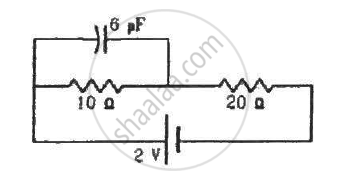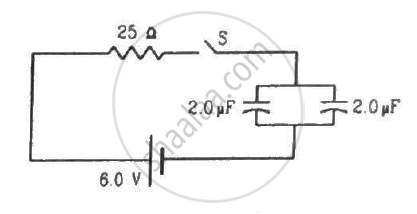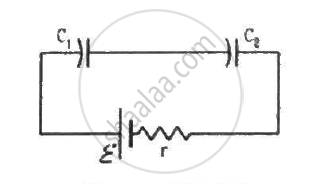Advertisements
Advertisements
Question
A capacitor of capacitance 12.0 μF is connected to a battery of emf 6.00 V and internal resistance 1.00 Ω through resistanceless leads. 12.0 μs after the connections are made, what will be (a) the current in the circuit (b) the power delivered by the battery (c) the power dissipated in heat and (d) the rate at which the energy stored in the capacitor is increasing?
Solution
Given,
Capacitance of capacitor, C= 12.0 μF = 12 × 10−6 F
Emf of battery, V0 = 6.00 V
Internal resistance of battery, R = 1 Ω
Time interval, t = 12 μs
(a) Charging current in the circuit is given as,
i = i0e−t/RC
Current at, t = 12.0 μs
\[i = \frac{V_0}{R} e^{- t/RC} \]
\[i = \frac{6}{1} \times e^{- 1} \]
\[i = 2 . 207 = 2 . 21 A\]
(b) During charging, charge on the capacitor at any time ''t'' is given as
\[Q = C V_0 (1 - e^{- \frac{t}{RC}} )\]
Work done by battery in in time delivering this charge is,
W = QV0
Power deliver by the battery in time ''t'' is,
\[P = \frac{C {V_0}^2 (1 - e^{- \frac{t}{RC}} )}{t}\]
Putting, t = 12 μs
\[P = \frac{12 \times {10}^{- 6} {V_0}^2 (1 - e^{- 1} )}{12 \times {10}^{- 6}}\]
\[ \Rightarrow P = 13 . 25 W\]
(c) Energy stroed in the capacitor at any instant of time is given as,
\[U = \frac{1}{2}\frac{Q^2}{C}\]
\[ \Rightarrow U = \frac{1}{2}\frac{C^2 {V_0}^2 (1 - e^{- \frac{t}{RC}} )^2}{C}\]
\[ \Rightarrow U = \frac{1}{2}C {V_0}^2 (1 - e^{- \frac{t}{RC}} )^2\]
Rate at which the energy stored in the capacitor is,
\[\frac{dU}{dt} = \frac{1}{2}C {V_0}^2 \times 2(1 - e^{- \frac{t}{RC}} ) \times ( e^{- \frac{t}{RC}} ) \times \frac{1}{RC}\]
\[\Rightarrow \frac{dU}{dt} = \frac{{V_0}^2}{R}( e^{- \frac{t}{RC}} - e^{- \frac{2t}{RC}} )\]
\[ \Rightarrow \frac{dU}{dt} = \frac{6 \times 6}{1}( e^{- 1} - e^{- 2} )\]
\[ \Rightarrow \frac{dU}{dt} = 8 . 37 W\]
So, the power dissipated in heat = \[P - \frac{dU}{dt}= 13.25-8.37 = 4.87 W\]
(d) Rate at which the energy stored in the capacitor is increasing
\[\Rightarrow \frac{dU}{dt} = 8 . 37 W\]
APPEARS IN
RELATED QUESTIONS
The energy density in the electric field created by a point charge falls off with the distance from the point charge as
Find the charge on the capacitor shown in the figure.

The plates of a capacitor of capacitance 10 μF, charged to 60 μC, are joined together by a wire of resistance 10 Ω at t = 0. Find the charge on the capacitor in the circuit at (a) t = 0 (b) t = 30 μs (c) t = 120 μs and (d) t = 1.0 ms.
How many time constants will elapse before the energy stored in the capacitor reaches half of its equilibrium value in a charging RC circuit?
A capacitor of capacitance C is connected to a battery of emf ε at t = 0 through a resistance R. Find the maximum rate at which energy is stored in the capacitor. When does the rate have this maximum value?
A capacitance C charged to a potential difference V is discharged by connecting its plates through a resistance R. Find the heat dissipated in one time constant after the connections are made. Do this by calculating ∫ i2R dt and also by finding the decrease in the energy stored in the capacitor.
Find the charge on each of the capacitors 0.20 ms after the switch S is closed in the figure.

Consider the situation shown in figure. The switch is closed at t = 0 when the capacitors are uncharged. Find the charge on the capacitor C1 as a function of time t.

A point charge Q is placed at the origin. Find the electrostatic energy stored outside the sphere of radius R centred at the origin.
A large conducting plane has a surface charge density `1.0 xx 10^-4 "Cm"^-2` . Find the electrostatic energy stored in a cubical volume of edge 1⋅0 cm in front of the plane.
Answer the following question.
Obtain the expression for the energy stored in a capacitor connected across a dc battery. Hence define energy density of the capacitor
Choose the correct option:
Energy stored in a capacitor and dissipated during charging a capacitor bear a ratio.
A capacitor is charged by a battery and energy stored is 'U'. Now the battery is removed and the distance between plates is increased to four times. The energy stored becomes ______.
An air-filled parallel plate capacitor has a uniform electric field `overset(->)("E")` in the space between the plates. If the distance between the plates is 'd' and the area of each plate is 'A', the energy stored in the capacitor is ______
(∈0 = permittivity of free space)
Do free electrons travel to region of higher potential or lower potential?
A parallel plate capacitor (A) of capacitance C is charged by a battery to voltage V. The battery is disconnected and an uncharged capacitor (B) of capacitance 2C is connected across A. Find the ratio of total electrostatic energy stored in A and B finally and that stored in A initially.
Electrostatic energy of 4 x 10−4 J is stored in a charged 25 pF capacitor. Find the charge on the capacitor.
Derive an expression for energy stored in a capacitor.
